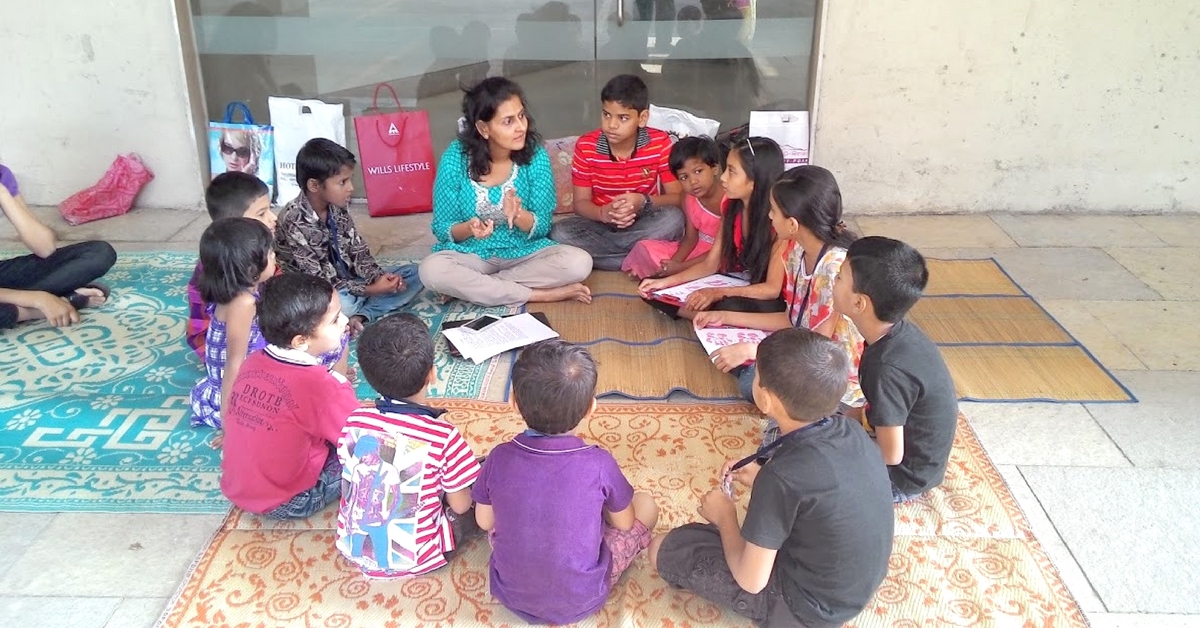This Mumbai Society Is Bridging Gaps by Teaching Kids From Their Impoverished Neighbourhood
Residents of a luxury apartment complex in Mumbai volunteer every weekend to teach the kids in their poor neighbourhood, and bridge the gap between them.

There was a time when Mumbai was the hub of the cotton textile industry in India. Central Mumbai was full of textile mills, surrounded by chawls that housed the mill workers. These mills, which lie on many acres of prime land, have been defunct for decades. In the last few years, many of these mills have been bought by builders, who have razed them and built luxury apartments for private residences.
We now have a cluster of high-rise buildings on a 10-15 acre plot, alongside tightly packed chawls. The mill workers now come to the same address, to work as maids, cooks, and drivers. Inside the apartment complex, it is green, beautiful, with many amenities and luxuries. Outside, it is a different world and there are high walls to keep that world out.
What the Ashok Gardens society has done, however, is bridge the gap between the two worlds. The Social Connect initiative was started to engage with the neighbours.
For over three years now, every Saturday a group of resident volunteers conduct classes for the neighbourhood children.

Children range in the age group of 5-12 years. For some activities, they would all be together. For some, they are broken up into groups based on their age. The batch size is 24 children and there is always a wait-list. While most kids continue, some kids leave if they are moving out of the neighbourhood or if they are studying in higher classes and are busy with academics.
Every class starts with 10 minutes of yoga, followed by art-and-craft, storytelling or music and dance. Over the years, conversational English was also introduced, with the curriculum developed by a group of volunteers.
For some months, learning may be based on a theme. For example, during the flamingo season, they learnt about the wading bird and migration, did a craft activity, and were taken to see the flamingos in the Sewri flatlands. Another month, the theme was Indian Independence. They discussed the freedom struggle, learned patriotic songs, and even performed for the appreciative residents on Independence Day. There was also a module on civic awareness. In groups, they built model cities, which were judged by BMC officials who spoke to the kids about waste management. The kids did a few modules of origami and were taken to an origami exhibition. On one occasion, in keeping with the theme, they also watched a movie in the building’s theatre. These are just examples of the variety of classes and activities. The children get holidays as per the school calendar.
The classes are conducted entirely by the residents. A group of them also take turns providing snacks for the class. A modest corpus, built from donations from the core group and part proceeds from a book sale, takes care of expenses, if any. Spending is prudent and meticulous accounts are maintained.
In addition to these weekly classes, a medical camp and a financial literacy camp were also conducted under the Social Connect umbrella. It was open to the domestic help of the building and their neighbours, so it was another way to engage with the community.
There are challenges. Volunteers need to feel motivated. Another challenge has been to decide on the format. Does one introduce some academics, build a curriculum? Or does one conduct classes and build skills not taught in schools? Every term, the core group meets and discusses learnings and the way forward.
The initiative has always had the full support and backing of the various managing committees.

That has helped in a big way in its continuity. But the biggest reason for the success of this initiative is the dedication of the volunteers. A few senior citizens who are deeply involved say that this interaction with the children brings them a lot of joy. I myself had the opportunity to volunteer for a few sessions, and it was an amazing experience. The children are smart and interested, and working with them is incredibly fulfilling.
We may have started this off to give back to the community, but over the years, we discovered that we get a lot out of it ourselves.
As the cityscape changes, and as such residential buildings increasingly come up in hitherto lower middle class neighbourhoods, I think it would be wonderful if all societies took up activities such as these. As a society, as a country, as the world, we need to build more bridges, and less walls.
(Written by Aadhya Shivakumar)
Like this story? Or have something to share?
Write to us: [email protected]
Connect with us on Facebook and Twitter.
NEW: Click here to get positive news on WhatsApp!
This story made me
- 97
- 121
- 89
- 167
Tell Us More
We bring stories straight from the heart of India, to inspire millions and create a wave of impact. Our positive movement is growing bigger everyday, and we would love for you to join it.
Please contribute whatever you can, every little penny helps our team in bringing you more stories that support dreams and spread hope.



















